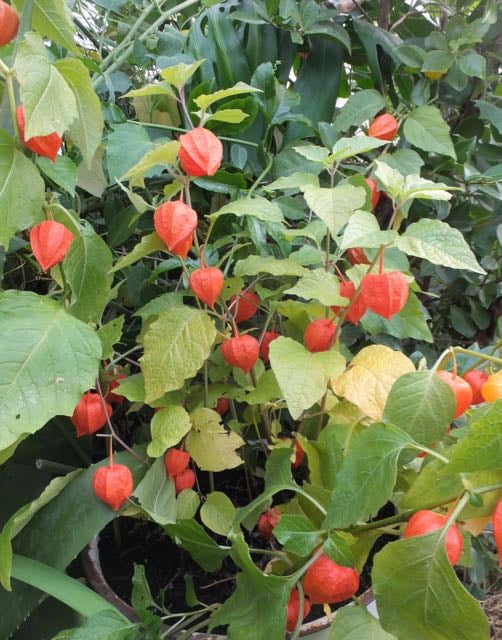For a wonderful display in your greenhouse or conservatory all winter through you just cannot beat Chinese Lanterns. These are long stems festooned with numerous orange ‘flowers’ and so called as they so closely resemble brilliantly coloured paper decorations.
Also known as Bladder Cherries Physalis alkekengi really are most distinctive and have been grown since ancient Greek times, both in Europe and Japan while the name alkekengi is Arabic.

Chinese Lanterns are closely related to other Physalis from S. America such as the Cape Gooseberry grown for their fruit. And although the red berry inside the inflated scarlet husk is edible (and was once esteemed) it’s for those highly visible papery bladders this plant is grown. Unlike other Physalis Chinese Lanterns are fairly hardy in a dry warm spot. Indeed these are usually grown outdoors, where they are a bit prone to sprawl and ramble.
The real problem outdoors is that their show can be really great at leaf fall with staggering colour but then the weather soon beats the husks down and by midwinter they’ve been obliterated.
However either grown, or brought under cover, in tubs this plant is kept more compact making a denser display. And most importantly those vivid day-glow lanterns are not damaged by the weather so don’t lose their vibrancy throughout the cold months. Indeed they’ll hang till next autumn slowly bleaching.
Chinese Lanterns are just hardy so need no heat though are grown more rapidly under cover, where they prefer a sunny spot and good ventilation. You can start them off from seed easily, just like tomatoes, or by root division from a bought in plant which is a year quicker but will be identical. They’re not fussy and will enjoy any well drained compost with some light feeding and regular watering. Neither are they bothered by most pests and diseases other than grey mould which appears if the atmosphere gets too humid.
The long stems of lanterns can be cut for flower arrangements and dried for longer lasting displays. They may well dry back naturally but it’s best to cut back the tops hard in spring as growth resumes to get stronger new shoots.
Although the species seems identical with the variety franchetii there are a couple of unique sorts such as Gnome and the impressive Gigantea with even bigger bladders.


